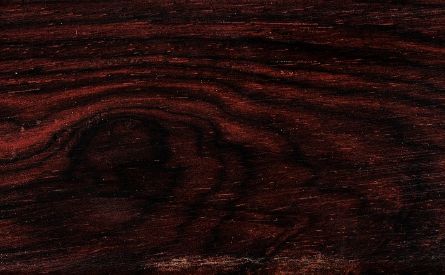COCOBOLO
Cocobolo / Dalbergia retusa

Local Names
Granadillo, Palo de Rosa, Ñambar, Palisandro, Caviuana, Funera, Cocoboloholz, 微凹黃檀
Distribution & Tree
A member of the Dalbergia genus of true rosewoods, such as include kingwood and tulipwood, cocobolo is found from Mexico across Central America to Panama, generally along the Pacific Coast, usually in the drier uplands and of limited occurrence in the understory of mixed hardwoods. A small to medium-sized tree, it reaches heights up to 20 meters and trunk widths of 60 cm. Its trunk is irregularly shaped.
Wood Appearance
Cocobolo’s heartwood can comprise in a medley of colors, lighter when freshly cut and darkening upon exposure with a palette ranging from yellow, orange, red, and brown with streaks of black or purple. Sapwood is typically a very pale yellow. Its grain is straight to interlocked, with a fine even texture and medium to high luster. It has a mildly fragrant aroma.
Processing Properties
It is highly stable with excellent drying properties, machines and finishes well (carbide- and Stellite-tipped tools are recommended), and takes a high polish. Due to its high oil content, it can occasionally cause problems with gluing. Its color can bleed into surrounding wood when applying a finish. Tear-out can occur during planing if interlocked grain is present; the wood also has a moderate blunting effect on cutting edges/tools due to its high density. Cocobolo has excellent machining properties and can be worked well with a scraper, which will help keep dust down. Some people are allergic to this wood, so wearing a mask during sanding it is highly recommended.
Strength & Durability
Denser and stronger than Brazilian rosewood (dried specimens sink in water), it is highly durable and resistant to attack by insects, decay and marine borers.
Wood Uses
Guitar back and sides, binding, high-end turnery, inlays, general woodcraft, knife and brush handles, canes, chess pieces, scientific instruments, jewelry, decorative veneer, automobile accessories (steering wheels and instrument boards), buttons, knobs, and cabinetry.
Ecological & Social Importance
Cocobolo’s name is said to be a Spanish corruption of the Arawak word kakabali. Panama’s local name for the wood took on worldwide prominence in the mid-19th century as that country emerged as a principal exporter. According to Cordero and Boshier, it is a contraction of the words meaning “ghost” and “trunk.”
| Reference Species | ||||
| Technical Characteristics | Cocobolo | Brazilian Cherry | Gonçalo Alves | |
| Density | kg/m3 | 1,095 | 910 | 961 |
| Janka Hardness | kgf | 1,342 | 1,219 | 1,026 |
| Bending Stiffness (Modulus of Elasticity) | GPa | 18.7 | 18.9 | 16.6 |
| Bending Strength (Modulus of Rupture) | MPa | 158.0 | 155.2 | 117.0 |
| Crushing Strength | MPa | 81.3 | 81.2 | 74.2 |
| Shrinkage, Radial | % | 2.7% | 4.2% | 4.2% |
| Shrinkage, Tangential | % | 4.3% | 8.0% | 7.8% |
| Shrinkage, Volumetric | % | 7.2% | 12.1% | 11.2% |
| T/R Ratio | 1.6 | 1.9 | 1.9 | |
| Values determined at 12% humidity - Provided for reference only | ||||
|---|---|---|---|---|
DENSITY
JANKA HARDNESS
BENDING STIFFNESS
BENDING STRENGTH
CRUSHING STRENGTH
SHRINKAGE
Values are for reference only and cannot be guaranteed. Wood is a natural material and physical and mechanical properties may vary depending on age, genetics, and other factors. We encourage customers to consult the references provided in the bibliography. For further explanations of wood’s key technical characteristics, an excellent resource is the Wood Database with articles on Density (average dried weight); Janka hardness; Elastic Modulus; Rupture Modulus; Crushing Strength; Radial, Tangential and Volumetric Shrinkage.






